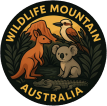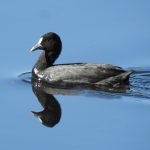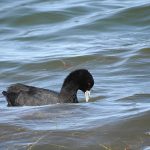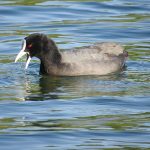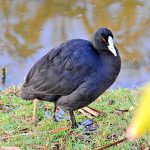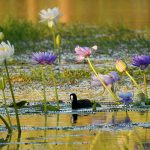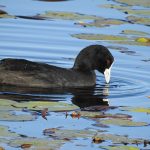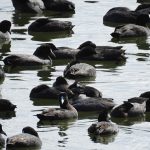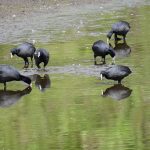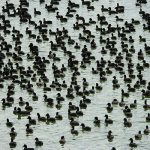EURASIAN COOT
Sharon: I found a nice mob of Eurasian Coots on a large outback Queensland dam where they seemed quite at home foraging amongst the reeds. I don’t often get to see them out of the water, so I was lucky, in this ‘Close Encounter’, to see them foraging around the edges of the dam as well.
The Eurasian Coot: An Australian Waterbird Tale
Amid the gentle ripples of Australia’s lakes and wetlands, a striking black waterbird glides with quiet determination—the Eurasian coot. Despite its name, this adaptable bird has made itself at home across the Australian landscape, weaving its story into the rich tapestry of the nation’s wildlife.
Where Do Eurasian Coots Live?
The Eurasian coot is truly cosmopolitan, found across:
- The eastern states, from Queensland to Victoria
- Stretching into South Australia
- Gracing the temperate wetlands of Western Australia and Tasmania
Their presence is marked by adaptability: wherever there is still or slow-moving water—be it a suburban pond, a sprawling wetland, or a quiet riverbank—coots are likely to be found.
Remarkable Adaptations
Lobed Toes: Nature’s Aquatic Advantage
Unlike many waterbirds that possess traditional webbed feet, coots have lobed toes. Each toe is edged with broad, flexible flaps of skin. This unique adaptation allows them to:
- Propel themselves efficiently through water
- Walk with surprising agility across muddy banks and floating vegetation
Assertive Defenders
Despite their modest size, coots are renowned for their boldness. During breeding season, they fiercely defend their territory, engaging in spirited chases and displays to ward off intruders. Their determination is a testament to their resilience.
Breeding and Family Life
Floating Nests
Coots are master builders, constructing floating nests from reeds and aquatic plants. These nests:
- Sit gently atop the water, swaying with every breeze
- Provide a safe cradle for their eggs, protected from many ground predators
Parental Care
Both parents share the responsibilities of:
- Incubating the eggs
- Feeding the chicks once they hatch, often ferrying food across the water
Their dedication ensures the next generation is nurtured in the gentle embrace of Australia’s waterways.
Lifespan and Conservation Status
- Lifespan: Up to 10 years in the wild, a testament to their adaptability and toughness.
- Conservation Status: Listed as Least Concern in Australia, their populations remain stable and widespread.
The Bigger Picture: Protecting Their Habitat
While the Eurasian coot’s current status is secure, their future is intertwined with the health of their environment. Threats such as:
- Pollution (chemical runoff, plastics)
- Habitat destruction (wetland drainage, urban development)
- Climate change (altered rainfall patterns, extreme weather)
can all have profound impacts on their serene existence.
A Shared Responsibility
By caring for our waterways—reducing pollution, protecting habitats, and supporting conservation efforts—we help ensure that Eurasian coots, and countless other species, continue to thrive. Their presence reminds us of the delicate balance of nature and the beauty that flourishes when we act as responsible stewards.
Experience the Coot: A Multi-Sensory Encounter
Imagine standing at the water’s edge:
- The coot’s jet-black feathers shine in the sunlight, offset by a bold white bill and forehead shield.
- You hear their distinctive croaks and whistles echoing across the water.
- The air is fresh with the scent of damp earth and aquatic plants.
- You watch as parents gently guide a train of fluffy chicks through rippling water, each movement a quiet celebration of life.
Conclusion: Celebrating and Safeguarding Nature
The story of the Eurasian coot is one of resilience, adaptability, and shared guardianship. In learning about these remarkable birds, we are reminded of our connection to the natural world and our role in preserving its wonders for the generations yet to come.
Let’s cherish the coots, and all our wild neighbours, by protecting the places they—and we—call home.
